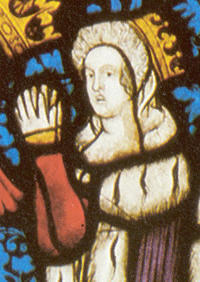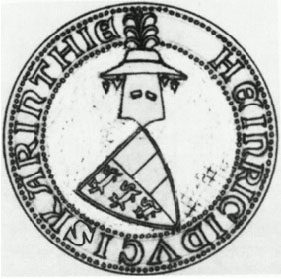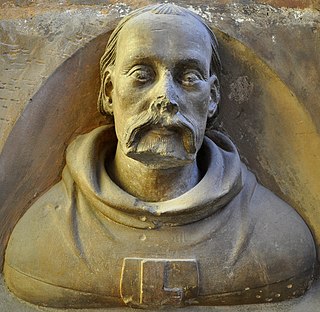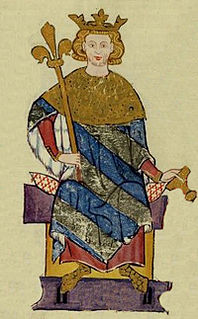 W
WAgnes of Bohemia (1305–1337) was the only child of King Wenceslaus II of Bohemia by his second wife, Elisabeth Richeza of Poland. She was a member of the Přemyslid dynasty.
 W
WAnne of Bohemia was Queen of England as the first wife of King Richard II. A member of the House of Luxembourg, she was the eldest daughter of Charles IV, Holy Roman Emperor and King of Bohemia, and Elizabeth of Pomerania. Her death at the age of 28 was believed to be caused by plague.
 W
WMatthias of Arras (c.1290–1352), sometimes spelled as Matthew of Arras was a French architect, famed for his work on St. Vitus Cathedral in Prague.
 W
WBonne of Luxemburg or Jutta of Luxemburg, was born Jutta (Judith), the second daughter of John the Blind, king of Bohemia, and his first wife, Elisabeth of Bohemia. She was the first wife of King John II of France; however, as she died a year prior to his accession, she was never a French queen. Jutta was referred to in French historiography as Bonne de Luxembourg. She was a member of the House of Luxembourg. Among her children were Charles V of France, Philip II, Duke of Burgundy, and Joan, Queen of Navarre.
 W
WCatherine of Bohemia was Electress of Brandenburg, the second daughter of Holy Roman Emperor Charles IV and Blanche of Valois.
 W
WCharles IV, born Wenceslaus, was the first King of Bohemia to become Holy Roman Emperor. He was a member of the House of Luxembourg from his father's side and the Czech House of Přemyslid from his mother's side; he emphasized the latter due to his lifelong affinity for the Czech side of his inheritance, and also because his direct ancestors in the Přemyslid line included two saints.
 W
WChristian of Prachatice was a medieval Bohemian astronomer, mathematician and former Catholic priest who converted to the Hussite movement. He was the author of several books about medicine and herbs, and contributed to the field of astronomy with many papers and data recordings.
 W
WElisabeth of Bohemia (1358–1373) was the daughter of Charles IV, Holy Roman Emperor, and Anne of Schweidnitz. She was named after her paternal grandmother, Elisabeth of Bohemia (1292–1330).
 W
WHenry, a member of the House of Gorizia (Meinhardiner), was Duke of Carinthia and Landgrave of Carniola and Count of Tyrol from 1295 until his death, as well as King of Bohemia, Margrave of Moravia and titular King of Poland in 1306 and again from 1307 until 1310. After his death, the Habsburgs took over Carinthia and Carniola, and held them almost without interruption until 1918.
 W
WHenry of Lipá was a prominent Czech nobleman, marshal, and powerful magnate in the Kingdom of Bohemia.
 W
WJan z Jenštejna, German: Johann II. von Jenstein, Johannes VI. von Jenstein. Johann von Jenzenstein, Johann von Genzenstein was the Archbishop of Prague from 1379 to 1396. He studied in Bologna, Padova, Montpellier and Paris. He was also a poet, writer and composer.
 W
WJohn II, Duke of Opava-Ratibor was Duke of Opava-Racibórz (Ratibor), Krnov and Bruntál. From 1388 to 1397, he was also governor of Kłodzko and Ząbkowice Śląskie and from 1397 to 1422 pledge lord of Kłodzko and Ząbkowice Śląskie. He was a member of the Opava branch of the Přemyslid dynasty.
 W
WJohn the Blind was the count of Luxembourg from 1313 and king of Bohemia from 1310 and titular king of Poland. He is well known for having died while fighting in the Battle of Crécy at age 50, after having been blind for a decade.
 W
WPavel Kravař, or Paul Crawar, Paul Craw, was a Hussite emissary from Bohemia who was burned at the stake for heresy at St Andrews in Scotland on 23 July 1433. He was the first of a succession of religious reformers who were martyred in the town during the course of the subsequent Protestant Reformation..
 W
WKunigunde of Bohemia was the eldest daughter of Ottokar II of Bohemia and his second wife, Kunigunda of Slavonia. She was a member of the Přemyslid dynasty. She was Princess of Masovia by her marriage to Boleslaus II of Masovia and later became abbess of the St. George's Convent at Prague Castle.
 W
WMargaret, nicknamed Margarete Maultasch, was the last countess of Tyrol from the House of Gorizia (Meinhardiner), and an unsuccessful claimant to the Duchy of Carinthia. Upon her death, Tyrol became united with the Austrian hereditary lands of the Habsburg dynasty.
 W
WThe Master of the Třeboň Altarpiece, was a Bohemian painter active in Prague around 1380-1390. His name is derived from the Třeboň Altarpiece from the church of Saint Eligius at the Augustinian convent of Třeboň. The triptych depicts Christ on the Mount of Olives, The Tomb of Christ, and the Resurrection. It has been dated to around 1380, and is today held at the Convent of St. Agnes branch of the National Gallery in Prague.
 W
WJohann Parler the Younger, was a Bohemian architect of German origin from the prominent Parler family of architects, master builders, and sculptors. He was the son of famous Gothic architect Peter Parler, the builder of Saint Vitus Cathedral and Charles Bridge in Prague. His uncle was Johannes von Gmünd also known as Johann Parler the Elder, a German Gothic master builder who was architect of Freiburg Minster and also rebuilt the damaged Basel Minster.
 W
WPeter Parler was a German-Bohemian architect and sculptor from the Parler family of master builders. Along with his father, Heinrich Parler, he is one of the most prominent and influential craftsmen of the Middle Ages. Born and apprenticed in the town of Schwäbisch Gmünd, Peter worked at several important late Medieval building sites, including Strasbourg, Cologne, and Nuremberg. After 1356 he lived in Prague, capital of the Kingdom of Bohemia and seat of the Holy Roman Empire, where he created his most famous works: St. Vitus Cathedral and the Charles Bridge.
 W
WPřemek I, Duke of Opava' was a member of the Opava branch of the Bohemian Přemyslid dynasty. He was Duke of Opava from 1367 until his death and Głubczyce from 1394 until his death.
 W
WSigismund of Luxembourg was prince-elector of Brandenburg from 1378 until 1388 and from 1411 until 1415, king of Hungary and Croatia from 1387, king of Germany from 1411, king of Bohemia from 1419, king of Italy from 1431, and Holy Roman Emperor from 1433 until 1437, and the last male member of the House of Luxembourg.
 W
WVladislaus II of Opole was a Duke of Opole from 1356, Count palatine of Hungary during 1367–1372, ruler over Lubliniec since 1368, Duke of Wieluń during 1370–1392, ruler over Bolesławiec from 1370, Governor of Galicia–Volhynia during 1372–1378, ruler over Pszczyna during 1375–1396, Count palatine of Poland in 1378, Duke of Dobrzyń and Kujawy during 1378–1392, ruler over Głogówek from 1383 and ruler over Krnov during 1385–1392.
 W
WWenceslaus II Přemyslid was King of Bohemia (1278–1305), Duke of Cracow (1291–1305), and King of Poland (1300–1305).
 W
WWenceslaus III was King of Hungary and Croatia between 1301 and 1305, and King of Bohemia and Poland from 1305. He was the son of Wenceslaus II, King of Bohemia, who was later also crowned king of Poland, and Judith of Habsburg. Still a child, Wenceslaus was betrothed to Elizabeth, the sole daughter of Andrew III of Hungary. After Andrew III's death in early 1301, the majority of the Hungarian lords and prelates elected Wenceslaus king, although Pope Boniface VIII supported another claimant, Charles Robert, a member of the royal house of the Kingdom of Naples.
 W
WWenceslaus IV was king of Bohemia from 1363 until his death, as well as king of Germany from 1376 until he was deposed in 1400. He belonged to the House of Luxembourg.